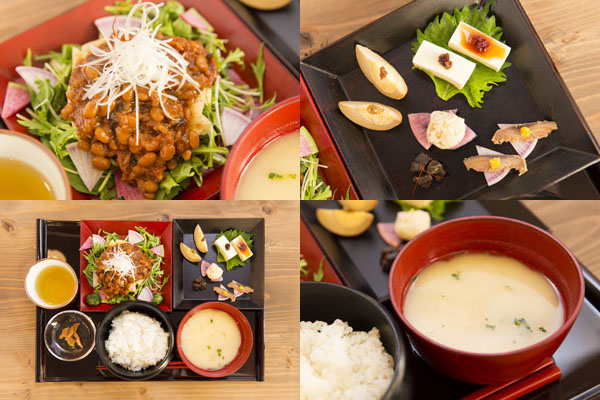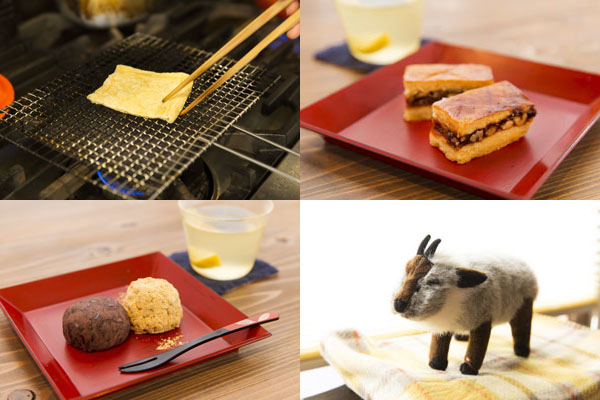Kamoshika Fermentation Shokudo: A Unique Fermentation Diner
Mar 04,2016
Kamoshika Fermentation Shokudo: A Unique Fermentation Diner
Mar 04,2016
Regular Japanese meals have long been enriched by many fermented foods including miso, soy sauce, vinegar, mirin rice wine, and fermented natto soybeans. Fermented foods and their umami flavorings are produced by the actions of endemic microorganisms and offer a host of benefits to the human body. Fermented foods, moreover, contain the hard-earned wisdom of our ancestors and are deserving to be passed on to future generations. In this series, we will present recipes that are easy to incorporate into today’s lifestyles while getting at the essence of fermented foods.
For Part 6, we visited the Kamoshika Fermentation Shokudo, a new hot spot in Kyoto’s Arashiyama district that makes the most of fermented foods.
▶Natto: Japan’s Fermented Tradition with Easy Recipes
▶Tamana Shokudo: Aoyama’s Brown Rice & Vegetable Spot

Kamoshika is open only during lunch hours. Nevertheless, nearly everything the cafeteria-styled restaurant serves is fermented, from its signature eight-dish fermentation set meal and its beverages — including teas, juices, and even saké — to its post-meal sweets. We were curious why Kamoshika is so focused on fermentation.
Owner Seki Megumi answers with a smile: “For some reason, all my favorite foods like miso soup, natto, and saké are fermented.” In university, Seki studied healthcare management and later worked as a healthcare consultant. In these positions, she became keenly aware of the importance of food, based on the idea that the prevention is the key to health. Then, as a mother of two, she discovered the power of traditional Japanese fermented food as she sought out dishes that were healthy for her family.
“The concept behind Kamoshika is ‘life is energized by life’. The two lives in this expression are human life and the microorganisms that are essential for fermentation. On one hand, human assistance is needed to keep microorganisms active and thriving. On the other, humans can regulate their physical condition by eating the fermented foods that microorganisms produce. In my opinion, the reason that a hot bowl of miso soup makes us feel relaxed and comforted, or that pickles give us a refreshing pick-up, is due to fermentation.”
The word “Kamoshika” literally means fermenting house. Here you can enjoy all the tastes of fermented foods, such as miso, soy sauce, natto, pickles, and cheese, that are fostered, and whose umami and aroma have been enriched, by the actions of microorganisms and enzymes.
“The basic idea is the feeling of wanting to share the things you like. The sensation of deliciousness and the invigoration that comes with eating fermented food might just well be a reaction among Japanese people at the DNA level.”
Kamoshika has a display space called the Fermenter’s Shelf with rows of old pickled ume plums, miso, and fermented moromi mash. It’s overwhelming to think that these are all alive. As we pondered this, the eight-dish fermentation set meal arrived. We immediately got started while it was still hot.


The daily eight-dish fermentation set meal, with its vivid colors, pleases the eye too. Starting with the plate in the top right, and working clockwise, are two pieces of tofu placed on shiso leaves: one topped with homemade ume plum paste sauce and one with homemade miso. The rich homemade sauce and miso enhance the sweetness of the local Kyoto-produced tofu. It’s a subtle but wonderful contrast.
Next are two pieces of pickled mackerel produced by an age-old method that involves maturing mackerel from Fukui in a rice bran paste for a year. The dish is served with seasonal condiments and vegetables (daikon radish on the day of our visit). The saltiness is so extraordinary and the umami of the fish so concentrated, just one slice would be enough for an entire bowl of rice.
This is followed by spicy konjac in fish sauce. The fish sauce from Ishikawa, made by fermenting sardines in salt, is one of Japan’s three major fish sauces, standing alongside Shottsuru fish sauce from Akita and Ikanago Shoyu fish sauce from Kagawa. The dish has a uniquely deep flavor thanks to its natural umami-infused seasoning.
Resting atop the smoked boiled eggs are yuzu kosho, a condiment made by pickling green chilis, koji, salt, and yuzu citrus for a year, and pickled fugu [pufferfish] roe. Fugu roe (ovaries) are extremely poisonous in their natural state. However, if you pickle the roe in salt and rice bran for over two years, they transform into a delicacy. You can truly sense the latent power of fermentation, which can transmutate the highly poisonous roe into a first-class side dish. Although the amount is small, the impact is massive. Once you’ve tasted this treat, you will never forget its vigor. It’s so delicious, it hurts.
In the middle of the first plate are local vegetable pickles. On the day of our visit, we were served turnips. The homemade fermented seasoning provides a crisp sourness.
Resting on the red square plate is deep-fried tofu dressed with a fermented starchy sauce. The special Kamoshika koji and natto starchy sauce uses koji sourced from a female koji producer in Kyoto. The special starchy sauce was developed by Seki through a process of trial and error by adding and subtracting various ingredients including natto, rice koji, soy sauce, mirin rice wine, kelp, and carrots. The rich taste is more reminiscent of miso than natto and the dish has no unpleasant smell. More like a curry than a starchy sauce, this dish again reminds you of the power of fermentation.
The set meal’s overall impression is one of deep, robust flavors. Fermentation highly concentrates the deliciousness of the ingredients, giving them a powerful presence. Typical of this rich flavor is the enzyme juice, which is made by adding sugar to such citrus fruits as yuzu, karin, and sudachi and letting it to stand for three weeks. This process concentrates the fruits’ umami so much that even when the juice is diluted with hot water to a third or a fifth of its original concentration, the taste profile remains crystal clear.
In contrast, the miso soup made with white miso and tofu has a mildly sweet and gentle flavor. The two sweet dishes — an ohagi rice ball made with amazake for its sweetness and a “monastery” galette, which consists of baked dough fermented with natural yeast between which is sandwiched caramel cream made with walnuts and raisins — also offer gentle, relaxing flavors. And the awa bancha, a tea produced in Tokushima using lactic acid to ferment the tea leaves, has a familiar taste, with a sweetness and sourness that slowly soaks into the body.
The honest tastes, whether strong or mild, convey their appeal directly. We were reminded again that living fermented foods are not only invigorating, but also straightforward and simple to understand.
“In the past, it was a given that every home had fermented foods on hand. I would be delighted if people, after eating fermented foods at Kamoshika, got into making fermented foods at home.”
